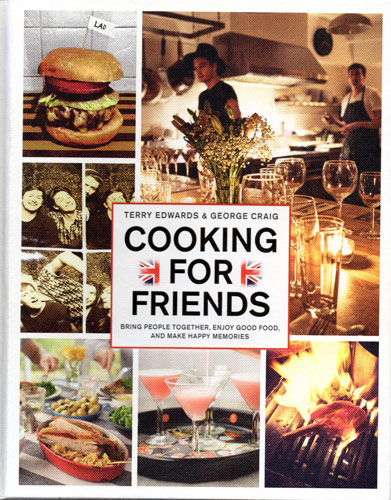A great divide: Mannered Northern ‘lads’ of culinary accomplishment & mundane musical meanderings.
If you cannot judge a book by its cover, and sometimes you can, you cannot always judge the quality of a cookbook by the quality of its prose, although you should by rights be entitled to do so. Sometimes bad prose accompanies bad recipes in the manner of Elizabeth David, but in her case not even that has prevented an ongoing outpour of adulation by word of mouth and critical acclaim.
Sometimes a good writer produces indifferent or untested recipes, but if the buyer must beware, the reader may enjoy the flavor of the writing instead of trying to take the book into her kitchen. Work by the irrepressible and irresistible Lesley Blanch fits that bill. She lived an outsize life clad in leopard print and caftans, pausing to write a pair of cookbooks including Around the World in Eighty Dishes. Each of them displays the sort of flamboyance that defined her wardrobe and neither is much more practical in the kitchen than her attire.
Cooking for Friends by the B-List celebrities Terry Edwards and George Craig suffers a number of disadvantages. At the outset its title is beyond banal, and does not really reflect the activity it describes. With apologies to Stevie Ray Vaughn for launching a musical allusion, it also labors under a kind of double trouble.

First, whether or not the style of language chosen for Cooking with Friends has any appeal when spoken, it seldom works in print, and does not work there. The would-be workingclass argot, however heartfelt, hardly trips off the page in the intended informal manner. Instead, it gets wearing, and wearying, and it gets there fast. Affectations that have ascended the annoyance register all the way to cliché include “Right, onto the first chapter;” “mates crashing out in front of the telly;” “Sod it!;” “And it’s not JUST about the food…. A cracking cocktail to greet your guests.”
Hyperbolic cliché also abounds. Burgers are “awesome,” pies “wicked,” gravy is “proper,” one dish is “the BEST,” a second “an absolute Classic” “in the foodie world” and another “went down a treat.” The authors’ addiction to block capitals and exclamation points becomes an inadvertent exercise in self parody. This kind of language may (or may NOT) prove pleasing to some when spoken, as its widespread emulation among English millennials, and in particular male ones may indicate, but the usage grates on the page, where it appears artificial.
The musical allusion is not inapt, and serves to introduce the second infirmity that plagues Cooking for Friends. “Music,” the authors confide, “is a massive part” of their “lives.”
Usage aside, that makes sense. Craig (though always ‘George’ in the book) is the frontman for the English band “One Night Only,” and has selected a soundtrack for each in a series of suggested dinners using recipes from the book. These “playlists” have, they claim, “struck a chord with so many people.” Cooks have had worse ideas, but in this case the ‘jukebox’ contains little that is connected to the food and nothing out of the ordinary. A typical list includes such original finds as the Beatles, Kinks, Led Zeppelin, Pink Floyd, Queen and the Who.
Bad writing or an absence of sonic originality, however, does not necessarily equate to lack of intelligence, and both Edwards (invariably ‘Terry’) and Craig (invariably ‘George’) seem smart, smart enough to build a decent business model that produces good things. Each of them can claim a real degree of accomplishment.
Speaking of models, Craig met Emma Watson during a photoshoot for Burberry and dated her for a time. Watson, who attended Oxford and even Brown, where she got her degree, is unlikely to have dallied with a dunce. Several songs by One Night Only have climbed the British charts, and Craig has continued his modeling career, for Urban Outfitters.
Edwards served apprenticeships under Paul Heathcote, Michel Roux the younger and Mark Hix, a most impressive triumvirate. Together Craig and Edwards created their business model, as they explain it
“a pop-up restaurant company focused on creating unique events. Imaginative yet unpretentious food is at the heart of our pop-ups, and bringing people together against the backdrop of a relaxed and friendly setting.”
Craig takes a hand in the kitchen but Edwards runs the culinary show, and gets top billing for Cooking with Friends. The authors seem amiable enough, and even though the book is an exercise in branding their sincerity and enthusiasm appear genuine.
 The lads.
The lads.
Their popup bears the unfortunate name ‘Check On,’ another attempt at vernacular workingclass hipsterosity, but there is nothing unfortunate about the foods they conjure. Recipes will be accessible to the least confident cook while incorporating enough originality into the British canon to appeal to the otherwise world-weary.
Yes, best of all theirs is a devoutly British cookbook despite a few foreign traces, a contribution to the canon that twists traditional techniques and ingredients without blurring its identity. That is meant as high praise indeed.
It can prove dispiriting to read a recipe, note a new combination or composition and wonder why someone else thought of it first. Nothing is better than getting that sinking sensation from reading a cookbook, and Cooking for Friends delivers the feeling. Nobody else, for instance, appears to have made hash with black pudding instead of beef. Why not? But why do Edwards and Craig poach their eggs before building the hash? They will only get cold or, if the cook follows the instruction to reheat them in boiling water, too firm, but the hash will not suffer from short hibernation in a slow oven.
Other flaws mar the book; the “ultimate” turkey sandwich follows an equally “ultimate” sandwich for steak. Another superlative, or no superlative at all, would have been less inelegant, but then elegance is hardly the style the authors have sought.
Notwithstanding the poached companions to the hash “[i]t always has to be fried eggs.” This type of fault, however, is minor, and as much the error of editor as of author. Edwards and Craig might have been better served by HarperCollins, but other publishers also have cut the corner when it comes to the blue pencil and colder eye.
Edwards and Craig make Cornish pasties with the traditional root vegetables but not with meat. Their pairing instead of smoked haddock and contrasting little crawfish tails is inspired, and so is a glaze for salmon built upon malt vinegar and English mustard. Rhubarb sauce may be traditional with mackerel and other oily fish, but they serve it with pork chops and sage butter instead. “It’s Yorkshire on a plate,” they yell, “in all its glory!” and they are right. These three dishes appear in the chapter called “Great British Classics” (along, haha, with that ‘classic rock’) but the description is unfair. The recipes are theirs to claim.
Another smart move; adding heat to a rich macaroni and cheese made with both sharp (‘mature’) Cheddar and red Leicester. Not just any heat; they add “jalapenos (from a jar)” for acid as well, a welcome contrast to the heavy cream and creamy cheese. Chanterelles leaven an otherwise traditional chicken pie, and they even use Old School Falcon pans to bake them.
Edwards and Craig, or Terry and George, or the stylists for Cooking with Friends anyway, also use Falcon for toad in the hole; red onion for their otherwise traditional gravy, a colorful, flavorful touch. The same tonal effect heightens the appeal of Lancashire hot pot via the agency of beets.
Falcon has been coating heavy gauge steel with enamel since the 1920s,“originally,” the maker coyly explains, “manufactured in the Black Country area near Birmingham, England.” Perhaps we should not scold them; everybody else has gone to China too, if that is where the factory has gone: Falcon does not say. But some things Falcon has not changed.
The pans remain “ice-white with the blue rim” and retain their “enduring strength” as the website insists. A Falcon pan “cannot burn. If you drop it, it may chip but it won’t break. Dishwasher-safe and oven-safe up to 530F/270C, it can also be used on gas and electric hobs.”
Falcon pans also conduct in an even manner ideal for baking savory puddings and pies, the kinds of things that Edwards and Craig do so well. Get some Falcons, get a copy of Cooking with Friends, get past its silly pose and get to work. It will be fun.
bfia versions of recipes from Edwards and Craig appear in the practical.

